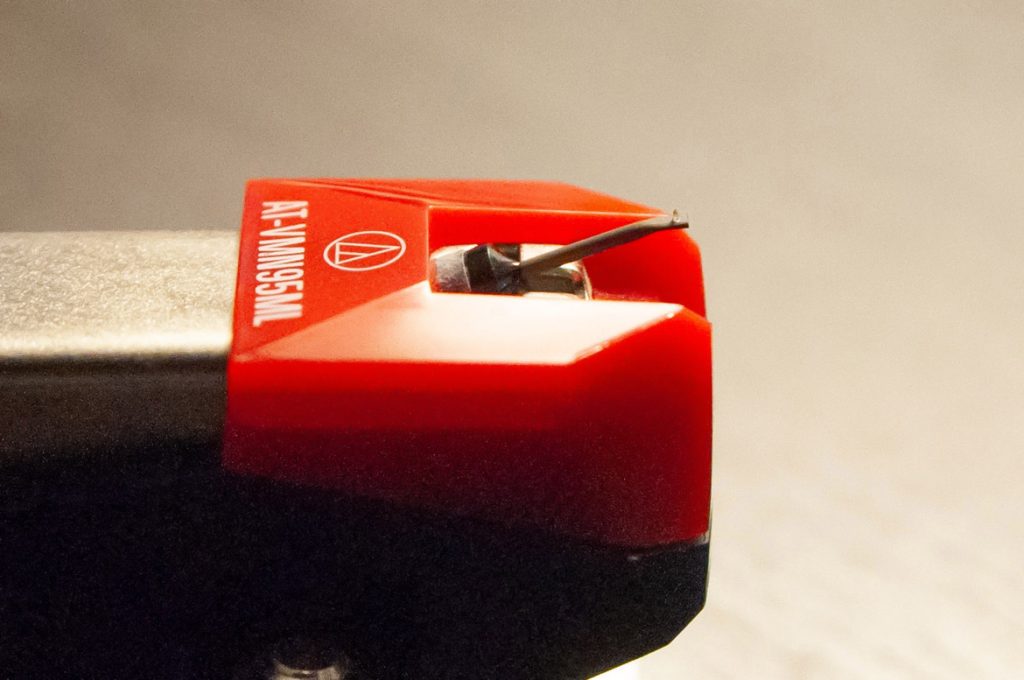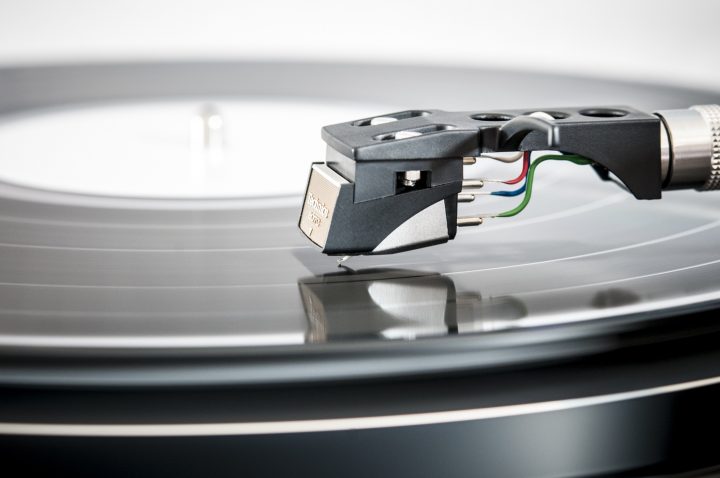This website offers free phono cartridge alignment protractors and other tools for turntable setup. Generate free custom alignment templates with our arc protractor, 2-point protractor and sightline protractor generators. The cartridge loading and and compliance caclulators will help you choose the right phono cartridge for your preamp and turntable.
What is a turntable protractor?
An alignment protractor is a tool for aligning the stylus and cantilever of a turntable cartride as precisely as possible to two null points. This is an important step when setting up a record player. Precise alignment minimizes distortion. Vinyl records sound better and last longer with a well aligned needle.
Is alignment with a protractor the same thing as adjusting the stylus overhang?
Yes, but a turntable protractor not only determines the correct overhang. It sets the offset angle as well. As there are many different alignment geometries to choose from, the overhang and angle determined by a protractor may be different from the geometry specified by the manufacturer, though. When setting up a turntable, it is important to stick with one geometry. Setting the overhang as specified by the manufacturer and then trying to set the offset angle with a random two point protractor will not work. It is a mistake that is commonly made.
How does turntable cartridge alignment work?
With a pivoted tonearm and the phono cartridge mounted at an offset angle, there are usually two null points at which the stylus is perfectly tangent to the grooves on the record surface. At these points the tracking error is zero, so no additional distortion is caused by the cartridge being at an angle. The exact location of the null points determines where on the record one will hear the most tracking distortion. The cartridge can only align to both null points at one particular overhang distance and offset angle. A protractor is the tool that will help you set this alignment. The instructions for each of our protractor generators will tell you how to align a turntable cartridge
Are alignment protractors for turntables universal?
2-point protractors and sightline protractors are universal and can be used on any turntable (provided the slots in the headshell are long enough to allow for the chosen alignment geometry). Arc protractors on the other hand are designed for a particular record player’s pivot to spindle distance.
What makes arc protractors so easy to use?
The great advantage of arc protractors is that overhang and offset angle are set independently. This makes aligning a turntable cartridge easier than with a 2-point protractor. Accuracy is easier to achieve than with a sightline protractor. It simply takes less effort to get a good result and minimal fine tuning is required.
Which kind of turntable protractor is the best tool for cartridge alignment? Universal 2-point, sightline or arc protractor?
If the pivot to spindle distance is known, using an arc protractor is highly recommended. If it is unknown, a universal protractor has to be used. The geometry can be set to the same specifications for either alignment tool, so the results should be the same if carefully done. Accuracy is the most difficult to achieve with a 2-point protracotor, though. We recommend checking the “overhang point” setting for greater accuracy and easier usage.
Where can I get an alignment protractor for my turntable?
This site allows to generate all types of alignment protractors free of charge. They can simply be printed out with a home printer. No download of software required.
How can I download a protractor from this site?
Use one of the turntable protractor generators on this site, open the browser’s printing dialogue and select “save as PDF” instead of a printer. To save a generated protractor for future use, you may also add a bookmark to your browser or save the URL. It is also possible to share your protractor with others by simply sending them a link.
Which alignment geometries and groove areas can I choose from?
The phono cartridge alignment tools on this site support them all. They will calculate null points for Baerwald, Löfgren B and Stevenson alignment geometries. IEC, DIN, JIS standards for the grooved area of the record can be selected as well as custom dimensions for the groove area and custom null points. The arc protractor generator can even calculate null points from the pivot to spindle distance, overhang and offset angle as specified by turntable manufacturers, making it easy to generate a perfectly matching protractor.
Which is better, aligning the cartridge body or the cantilever?
It depends. Aligning the cantilver has its limitations, as it is so short. This makes it very difficult, if not impossible, to set the overhang correctly with a two point protractor. It will look ok even if it is off by several millimeters. Another problem is the deflection of the cantilever when put onto a stationary protractor. Its angle can be different than on a spinning record.
Aligning the cartridge body is not a perfect solution either. By taping a pencil lead to a flat fronted cartridge, great precision can be achieved, but that requires the cantilever to be perfectly squared on the cartridge body, which is not always the case.
Sometimes aligning the cantilever is unavoidable, e.g. when the cartridge body has a curved front. Then it is best to avoid the two point protractor and use a sightline or arc protractor instead.
Why not use an overhang gauge instead?
There are various types of alignment gauges that come with turntables. Gauges are tools for setting a certain headshell tail to stylus tip distance. Some manufacturers only specify this distance instead of providing a gauge. The actual alignment geometry depends on the dimensions and shape of the tonearm. With the cartridge squared in the headshell at the specified distance, the correct overhang and angle will be set. Overhang gauges make alignment quick and easy, but they are not the most accurate tools. When carefully done – and if tonearm manufacturing tolerances are tight – good results can be achieved. To double check an alignment performed with an overhang gauge, please make sure to generate a protractor that matches the alignment specified by the turntable manufacturer precisely. A Baerwald protractor will not be compatible with a Stevenson alignment, as used by many Japanese turntable manufacturers. And Stevenson protractors will only be good for double checking when designed for the right inner and outer groove dimensions.
How is overhang measured?
Overhang is the distance between the stylus and the center spindle when the tonearm is moved right over the spindle. The protractors generated by this site will help to set the correct stylus overhang for the chosen geometry: On an arc protractor, the overhang is set correctly when the stylus can follow the arc all the way from one end to the other. On a two point protractor it is set correctly when the cartridge is perfectly aligned on both null points.
What is effective length?
Effective length is the distance between the tonearm pivot and the stylus tip. Adding up the pivot to spindle distance (also called mounting distance) and overhang will give you the effective length.
How to find out the pivot to spindle distance
Mounting distance or pivot to spindle distance is rarely mentioned in turntable manuals. Luckily it is easy to figure out, because overhang and effective length are almost always specified. Simply subtract the overhang from the effective length. The result is the pivot to spindle distance. The pivot to spindle distance is the only specification that one must know to generate an arc protractor.
Does every cartridge require precise alignment?
Yes. Spherical (also known as conical) styli have the reputation of being less sensitive about alignment than more advanced types such as elliptical, microline or Shibata styli. However, the same geometric principles apply to all stylus types. To minimize tracking distortion, any cartridge willl require proper alignment. When the first modern alignment geometries were developed by Erik Löfgren in 1938, elliptical needles were not even invented yet. Joseph F. Grado filed the patent for those 26 years later, in 1964!

The tiny microline stylus of an AT-VM95ML phono cartridge requires precise alignment
What else do I need to know to set up my turntable?
Alignment is important, but it is only one of many steps in setting up your turntable. Do not forget about anti-skate, vertical tracking force (VTF), vertical tracking angle (VTA), stylus rake angle and azimuth. Once you are done, you may use a test record to confirm you did a good job.
What is cartridge loading and why does it matter?
The phono cartridge forms a resonant filter with the input of the phono preamp. If the technical parameters are well matched, the frequency response will be close to linear.
What is cartridge compliance?
The cantilever of a turntable cartridge has a certain stiffness. It pretty much acts like a spring and is part of a mechanical system that involves the entire tonearm. This system will resonate at a subsonic frequency. The cartridge compliance needs to match the tonearm well, otherwise this resonance may cause problems. Use the resonance calculator to figure out whether a cartridge will work well for your record player.

